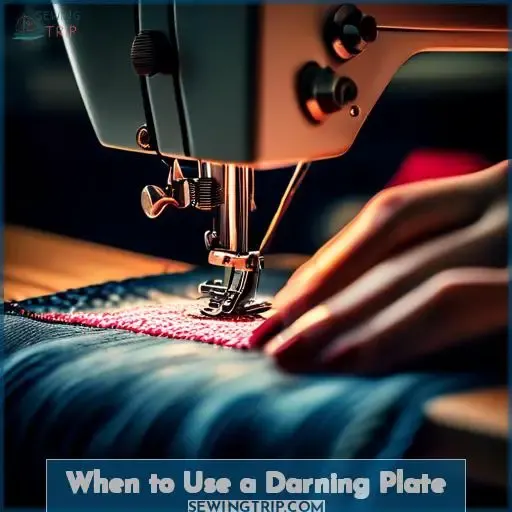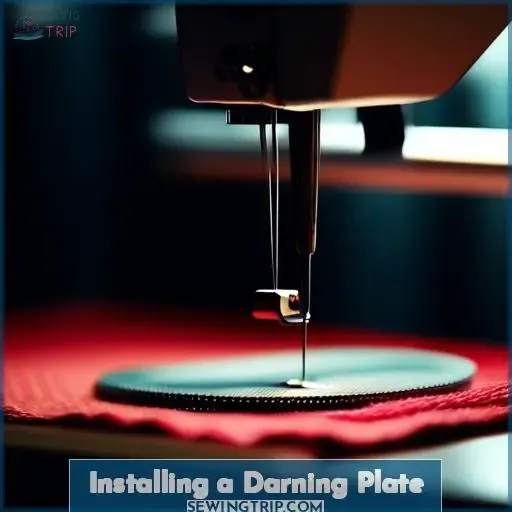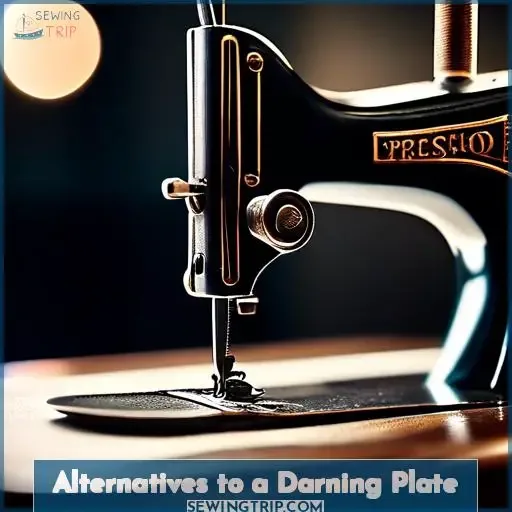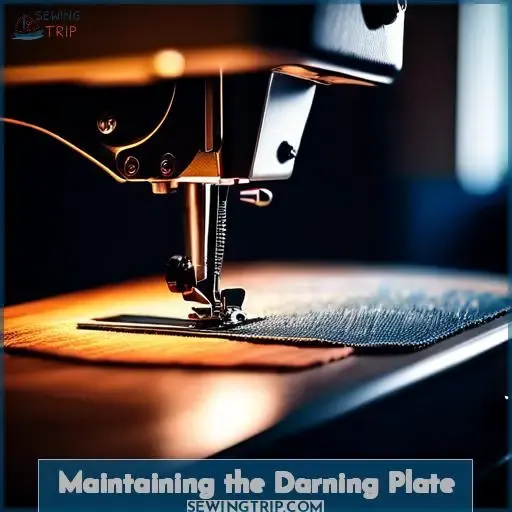This site is supported by our readers. We may earn a commission, at no cost to you, if you purchase through links.
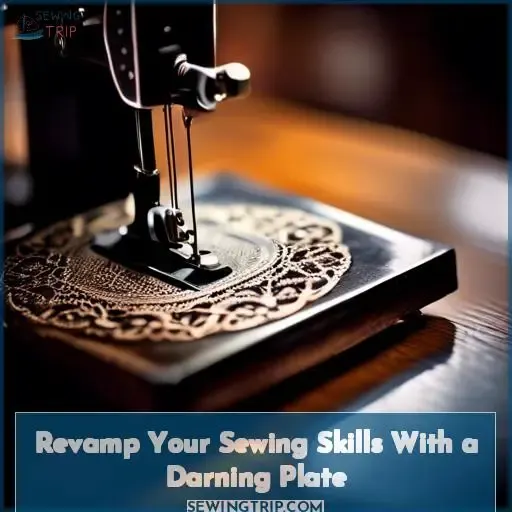
This specialized attachment allows for efficient sewing, perfect for tasks like darning holes or embroidering.
Mastering the use of a darning plate can elevate your sewing skills, enabling you to achieve precise repairs and enhancements with ease.
Table Of Contents
Key Takeaways
- A darning plate is a specialized attachment for sewing machines that covers the feed dogs, allowing for free fabric movement during darning, embroidery, and quilting.
- It provides control over the fabric during these processes and can be used as a powerful tool for sewing.
- The darning plate is suitable for free-motion embroidery, darning holes and worn areas, quilting without feed dogs, and can be used on machines without drop feeds.
- Alternatives to a darning plate include using a card or stencil to cover feed dogs, lowering stitch length to zero, quilting in the ditch or close to seams, free-motion quilting techniques, embroidery loop usage, and bobbin-work embroidery thread choices.
- The benefits of using a darning plate include preventing feed dogs from pulling fabric, allowing for smoother, more precise stitching, and being a game-changer for sewers seeking advanced skills.
What is a Darning Plate?
A darning plate is a specialized attachment for your sewing machine that covers the feed dogs, allowing you to move the fabric freely for tasks like free-motion embroidery and quilting. It’s a handy tool that can expand your sewing capabilities beyond basic stitching.
Purpose of a Darning Plate
A darning plate is a handy tool that covers the feed dogs on your sewing machine, giving you the freedom to control the fabric during embroidery, darning, and quilting. By using a darning plate, you can sew without the feed dogs pulling the fabric, allowing for smoother, more precise stitching.
It’s a game-changer for sewers who want to take their skills to the next level.
Difference From a Darning Foot
A darning plate is a tool that covers the feed dogs on a sewing machine, giving you more control over the fabric during darning and embroidery.
It can also be used as a power tool for sewing, making the process more efficient.
Mastering the use of a darning plate requires understanding how to align and secure it, ensuring the needle punches through the covering.
This skill is valuable for producing high-quality repairs and enhancing your sewing abilities.
When to Use a Darning Plate
When to Use a Darning Plate:
- Free-motion Embroidery: Darning plates are designed for free-motion embroidery, allowing you to move the fabric around freely without the feed dogs interfering. They’re particularly useful when working on intricate designs or when you want to create a more natural look.
- Darning Holes and Worn Areas: Darning plates can be used to repair holes or worn areas in fabric, as they allow you to darn without the feed dogs moving the fabric. This is especially useful when working on delicate fabrics or when you need precise control over the stitching.
- Quilting Without Feed Dogs: If you want to quilt without the feed dogs moving the fabric, a darning plate can be used to cover them. This is particularly useful when working on large projects or when you want to achieve a specific stitching style.
Remember to remove the standard needle plate and align the darning plate with the needle bar before securing it with the claw and screw. Darning plates are available for machines without drop feeds and can be used for both darning and free-motion stitching.
Free-motion Embroidery
To create a darning plate for your sewing machine, you can use a darning plate or foot designed for free motion quilting.
Alternatively, you can cover the feed dogs with a playing card, business card, or index card.
You can also use a plastic stencil cut into pieces. Remember to check the feed dogs occasionally to ensure they haven’t chewed through the covering.
Darning Holes and Worn Areas
To cover feed dogs on a sewing machine, you can use a darning plate or foot designed for free motion quilting.
Alternatively, you can cover the feed dogs with a playing card, business card, or index card.
You can also tape a 3×5 card over the feed dogs or use a plastic stencil cut into pieces.
It’s essential to check the feed dogs occasionally to ensure they haven’t chewed through the covering.
Quilting Without Feed Dogs
A darning plate is a versatile tool that can liberate your sewing experience. It allows you to quilt without feed dogs, providing greater control over your fabric.
The darning plate can also serve as a power tool, enabling you to sew more efficiently and effectively. It can be used for button sewing or darning, making the process smoother and more productive.
However, mastering the use of a darning plate requires understanding how to cover the feed dogs and achieve the desired results. Darning plate alternatives include using a card or stencil to cover feed dogs, lowering stitch length to zero, or quilting in the ditch or close to seams.
Free-motion quilting techniques, embroidery loop usage, and bobbin-work embroidery thread choices can also enhance your sewing skills.
Installing a Darning Plate
To install a darning plate on a sewing machine, you need to follow these steps:
- Remove the standard needle plate:
- On some machines, you may need to lower or cover the feed dogs to prevent fabric movement.
- Unscrew the current foot from the machine.
- Align and secure the darning plate:
- Line up the darning plate with the needle bar on your sewing machine.
- Hook the claw of the darning plate around the main bar.
- Screw the darning plate into place.
- Check for proper fit and function:
- Ensure the needle lines up with the hole in the darning plate.
- Make sure the darning plate fits securely and doesn’t interfere with the needle’s movement.
You may also want to consider alternatives to a darning plate, such as using a card or stencil to cover the feed dogs, lowering the stitch length to 0 and using a quilting foot, or quilting in the ditch or close to seams.
Remember to maintain the darning plate by ensuring the needle punches through the covering before sewing and replacing the covering if the feed dogs chew through it. Check the feed dogs periodically to ensure they haven’t chewed through the covering.
Removing the Standard Needle Plate
Before you can master the art of free-motion sewing, you’ll need to swap out your machine’s standard needle plate.
Start by gently removing it, revealing the feed dogs beneath.
Next, grab your darning plate—this nifty shield will keep those feed dogs at bay.
Check that the plate aligns perfectly; a misfit could spell trouble.
Once aligned, secure it in place, ensuring your fabric glides smoothly without snags.
Aligning and Securing the Darning Plate
To install a darning plate on your sewing machine, start by removing the standard needle plate.
Then, align the darning plate with the needle bar and secure it using the hook claw.
Check for proper fit and function before using the darning plate for free-motion embroidery or quilting without feed dogs.
Remember to maintain the darning plate by ensuring the needle punches through the covering and replacing it if it becomes damaged.
Checking for Proper Fit and Function
Once you’ve got your darning plate snugly in place, it’s showtime for a little detective work. You’re aiming for a Goldilocks fit—not too tight, not too loose. Whip out your magnifying glass and give it the once-over.
If it’s playing nice with your fabric and needle, you’re golden. If not, it’s back to the drawing board.
| Feature | Checkpoint | Status |
|---|---|---|
| Fit | Snug, not strangled | |
| Functionality | Smooth fabric glide | |
| Friendship | Plays well with needle |
Keep those darning plate brands in mind for durability, and don’t shy away from a bit of troubleshooting.
Alternatives to a Darning Plate
If you don’t have a darning plate for your sewing machine, you can use alternative methods to cover the feed dogs.
Using a Card or Stencil: You can cover the feed dogs with a playing card, business card, or index card. Simply tape it in place and make a hole in it for the needle to go through. This works well for some machines and is a low-tech approach.
Lowering Stitch Length to Zero: Some machines allow you to lower the stitch length to zero. This can prevent the feed dogs from moving the fabric. Attach a quilting foot and try it out.
Quilting in the Ditch or Close to Seams: If your machine doesn’t have a way to drop the feed dogs, you can quilt close to the seams or in the ditch. This can be done with a quilting foot.
Remember to check the feed dogs occasionally to ensure they haven’t chewed through the covering.
Using a Card or Stencil to Cover Feed Dogs
When you can’t find a darning plate or simply want an alternative, you can use a card or stencil to cover the feed dogs on your sewing machine.
- Use a playing card, business card, or index card.
- Tape a 3×5 card over the feed dogs.
- Use a plastic stencil cut into pieces.
- Check the feed dogs occasionally to ensure they haven’t chewed through the covering.
Lowering Stitch Length to Zero
Lowering the stitch length to zero is an alternative method to using a darning plate for covering feed dogs on a sewing machine.
This technique allows for needle movement and fabric manipulation, enabling the sewer to achieve the desired tension adjustment and thread experimentation.
By reducing the stitch length, the feed dogs are effectively disabled, providing the freedom to sew without their interference.
This method is particularly useful for quilting in the ditch or sewing close to seams, where precision and control are key.
Quilting in the Ditch or Close to Seams
Quilting in the ditch or close to seams is an alternative to using a darning plate. This method involves sewing along the edges of seams or in the ditch between two layers of fabric. It can be useful for quilting without feed dogs or for creating intricate designs.
- Controlled Movement: By sewing close to the seam, you have more control over the movement of the fabric, which can help you achieve more precise stitching.
- Fabric Manipulations: This method allows for more manipulation of the fabric, as you can easily move the fabric along the seam to create the desired effect.
- Intricate Designs: Quilting in the ditch or close to seams can be used to create complex designs, as you can control the stitching to create patterns and shapes.
Maintaining the Darning Plate
To keep your darning plate in top shape, it’s crucial you ensure the needle can punch through the cover without hindrance. If the feed dogs manage to chew through, replacing the cover promptly will prevent any damage to your project.
Ensuring the Needle Punches Through the Cover
When using a darning plate, ensure the needle penetrates the cover to prevent feed dog damage. Check the cover’s durability periodically to avoid puncture issues. Consider using alternative materials like cards or stencils for protection.
Mastering this skill empowers you to sew efficiently and achieve high-quality repairs, making your sewing experience smoother and more productive.
Replacing the Cover if It Becomes Damaged
When it comes to maintaining your darning plate, ensuring the needle penetrates the cover is crucial for preventing feed dog damage. If the cover becomes damaged, promptly replace it to maintain smooth fabric movement.
This simple step in damage prevention guarantees efficient sewing and repairs, unlocking the secrets to seamless stitching and enhancing your sewing skills effortlessly.
Checking the Feed Dogs Periodically
When it comes to maintaining your sewing machine, checking the feed dogs periodically is crucial. Ensure the needle punches through the covering to minimize fabric movement and optimize free-motion quilting.
Regularly inspect the feed dogs to prevent damage and replace the covering if needed. This simple step will keep your sewing machine running smoothly and your projects looking flawless.
Frequently Asked Questions (FAQs)
Can a darning plate enhance embroidery quality?
A darning plate is a tool used to cover the feed dogs on a sewing machine, allowing the user to sew without the feed dogs pulling the fabric.
This can be particularly useful when darning or embroidering, as it helps to prevent the fabric from being tugged during the sewing process.
By using a darning plate, the sewer has the freedom to control the fabric and achieve a neat repair.
Is a darning plate compatible with all fabrics?
A darning plate is a tool used to cover the feed dogs on a sewing machine, allowing the user to sew without the feed dogs pulling the fabric. This can be particularly useful when darning or embroidering, as it helps to prevent the fabric from being tugged during the sewing process.
By using a darning plate, the sewer has the freedom to control the fabric and achieve a neat repair. It can also serve as a power tool for sewing, enabling the user to sew more efficiently and effectively.
It can be used to sew on buttons or to darn holes and tears in fabric, making the sewing process smoother and more productive.
Using a darning plate can be a skill that requires mastery, as it involves understanding how to use the plate to cover the feed dogs and achieve the desired sewing results. This can be a valuable skill for sewers who want to enhance their sewing abilities and produce high-quality repairs.
Does a darning plate affect stitch tension?
A darning plate is a tool used to cover the feed dogs on a sewing machine, allowing the user to sew without the feed dogs pulling the fabric.
This can be particularly useful when darning or embroidering, as it helps to prevent the fabric from being tugged during the sewing process.
By using a darning plate, the sewer has the freedom to control the fabric and achieve a neat repair.
Can darning plates be used for buttonholes?
A darning plate is a tool used on a sewing machine to cover the feed dogs, allowing the user to sew without the feed dogs pulling the fabric.
This can be particularly useful when darning or embroidering, as it helps to prevent the fabric from being tugged during the sewing process. The plate can also serve as a power tool for sewing, enabling the user to sew more efficiently and effectively.
It can be used to sew on buttons or to darn holes and tears in fabric, making the sewing process smoother and more productive. Using a darning plate can be a skill that requires mastery, as it involves understanding how to use the plate to cover the feed dogs and achieve the desired sewing results.
This can be a valuable skill for sewers who want to enhance their sewing abilities and produce high-quality repairs.
Are darning plates suitable for heavy-duty sewing?
A darning plate is a tool used to cover the feed dogs on a sewing machine, allowing the user to sew without the feed dogs pulling the fabric. This can be particularly useful when darning or embroidering, as it helps to prevent the fabric from being tugged during the sewing process.
By using a darning plate, the sewer has the freedom to control the fabric and achieve a neat repair. Additionally, a darning plate can serve as a power tool for sewing, enabling the user to sew more efficiently and effectively.
It can be used to sew on buttons or to darn holes and tears in fabric, making the sewing process smoother and more productive.
Using a darning plate can be a skill that requires mastery, as it involves understanding how to use the plate to cover the feed dogs and achieve the desired sewing results.
Conclusion
Embark on your sewing journey with confidence by harnessing the power of a darning plate. This essential tool opens up a world of possibilities, from free-motion embroidery to seamless repairs.
With proper installation and maintenance, you can effortlessly elevate your sewing projects. Say goodbye to pesky holes and worn areas as you embrace the versatility of a darning plate on your sewing machine.
Let your creativity soar with this indispensable accessory!


